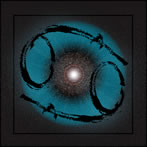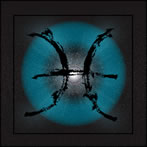Dear Friend and Reader:
This past Monday, the Sagittarius New Moon was conjunct a newly discovered centaur planet called Orius. The Moon-Sun conjunction was to the exact degree, which is usually a good moment to suss out some clues regarding what the new point is about. Technically called (330836) Orius, it was discovered on April 25, 2009, and named only recently.
A centaur is a Chiron-like planet, distinct for being smallish, and with an inclined path that crosses the orbits of other planets. They are much further from the Sun than asteroids, but are still inner Solar System objects, many with orbits going inside Saturn’s realm and only rarely extending beyond Neptune. All centaurs focus or intensify experience, are related to healing processes and bring what Carl Jung called shadow material to the surface. If used consciously, they are some of the best creative fuel available.
Orius was discovered at 3+ Scorpio, exactly opposite the Chiron discovery degree. It has an orbit of just over 100 years, so it has another close resonance with Chiron, whose orbit is just over 50 years. I prefer to publish something about these points before a potentially once-in-a-lifetime event such as a New Moon conjunct the new discovery, but this time I got going on my research the weekend before it happened. [To read an article on how newly-discovered minor planets are delineated, check this PDF.]
I had some excellent help on the project. At one end of Europe, in Wales, Tracy Delaney, the programmer and author of Serennu.com (recently rated the best astrology secret on the web), went to work researching the charts in which this point appears, and helping come up with a delineation. At the other end of Europe, in Finland, Kirsti Melto, a minor planet researcher and Planet Waves blogger, began searching for personal and event charts connected to Orius.
Orius turned up as a prominent influence in the charts of Bill Gates and Steve Jobs (who both have it conjunct Eris and the Moon), Pablo Picasso, James Dean, French surrealist poet Arthur Rimbaud, American rock star and surrealist poet Jim Morrison (who said he was the reincarnation of Rimbaud), Edward Snowden and Julian Assange. In many ways their lives have defined eras of history, taking their professional lives to the level of profound cultural contribution.
All of these men are or were unusually influential people — bold innovators, each of whom changed the world in some significant way, all of whom as young men. Note, no women came up on our rapid survey, but that sometimes happens because astrology birth databases often have far fewer women than men. That is an issue that needs to be addressed.
This new centaur planet is also prominent in the life history of Malcolm X, and one of my very favorite Supreme Court decisions, the one that bans politicians from suing newspapers for libel, New York Times Co. v. Sullivan. Orius seems to have an affinity for top-notch iconoclastic art, social justice and activists who don’t take any bullshit.
Orius also turned up in the chart of Nelson Mandela, the first black president of South Africa, who reunified the country after many decades under the Apartheid regime. Orius seems to have an affinity for the Moon and Jupiter in the charts of influential people; in Mandela’s chart Jupiter is opposing it (accurate to a tiny fraction of a degree) and many other planets are in aspect to it.
The forced separation of blacks and whites in South Africa was one of the great blights on the world, and one of the most important political issues of the 1970s and early 1980s. Apartheid was largely brought down by activists who demanded that one institution after the next — banks, universities, corporations, pension funds, cities, towns, states, countries, whatever — divest their funds from anyone doing business with South Africa.
After being enriched for decades by numerous capitalist entities, Apartheid was, under public pressure, finally starved of money and died not a day too soon.
Through all of this, South Africa’s most compelling leader, Nelson Mandela, was in prison, first on Robben Island, then Pollsmoor Prison, then Victor Verster Prison. Under global pressure he was finally released in 1990. He served as president of the African National Congress from 1991 to 1997, and as president of South Africa from May 1994 through June 1999.
It is fair to say that he has become one of the most respected men of our extended era of history, for his contribution to peace, for his wisdom and compassion and for his willingness to endure hardship and oppression. First arrested in 1962, he served nearly a third of his long life in prison, much of it doing hard labor and in solitary confinement. While at Robben Island, he was permitted one letter and one visitor every six months.
Throughout that time, he and his fellow inmates took part in work and hunger strikes as part of the anti-Apartheid struggle.
Planet Waves copy editor and horoscope coordinator Jessica Keet grew up in South Africa until she was 23. “I for sure knew nothing of the apartheid struggle or not in depth anyway,” she said Thursday — something I had not considered, that young caucasian people were not told what was going on around them.
But still as a schoolgirl she remembers writing FREE MANDELA on her pencil case. She admired Mandela in part because “he came out of 27 years in jail with no trace of bitterness whatsoever.”
“In a way I had never quite comprehended before, I realized the role I could play in court and the possibilities before me as a defendant,” he said in 1994, describing how he handled his trial.
“I was the symbol of justice in the court of the oppressor, the representative of the great ideals of freedom, fairness and democracy in a society that dishonoured those virtues. I realized then and there that I could carry on the fight even in the fortress of the enemy.”
In his inaugural speech the same year, he said, “The task at hand will not be easy. But you have mandated us to change South Africa from a country in which the majority lived with little hope, to one in which they can live and work with dignity, with a sense of self-esteem and confidence in the future.”
Nelson Mandela’s natal chart is noteworthy mostly for its sensitivity. He was born with the Sun in Cancer, the Moon in Scorpio and Eris in late Pisces. There are not a lot of people left on the planet who have Eris in Pisces (nearly everyone has it in Aries, where it still is today).
Also in Cancer is a conjunction of Jupiter and Pluto, one of my favorite pairings, which I call the Golden Thread aspect. It gives a thirst for social justice as well as the ability to translate fluently among and between any spiritual or religious paths. Jupiter and Pluto were opposed by Orius, which distinguished Mandela as an innovator. Mars in Libra square that alignment illustrates a fighting spirit, but done in a beautiful way, in the spirit of Libra.
In the mix (also in Libra, very closely square Jupiter and Orius) is one of the first-discovered centaurs, called Asbolus, which I describe as the survivor. Its name means carbon dust, and people with strong Asbolus in their charts seem able to withstand very nearly any adversity, dust themselves off and get on with their lives.
 |
|
Nelson Mandela, with his wife, Winnie, walks to freedom after 27 years in prison on Feb. 11, 1990, in Cape Town.
|
This arrangement, finally, is squared by a Chiron-Nessus conjunction, in Aries, right near the Aries Point. Mandela had a lot of centaurs working with his Mars, Jupiter and Pluto. No wonder he was a powerhouse, and one who seemed to understand everyone and everything.
He also has clusters of planets in Gemini and Leo, which describe how articulate, self-aware and strong he was — and which hint that his wisdom was coming from someplace long ago and far away.
We might say that the world has lost a beautiful soul in Nelson Mandela, though it’s more appropriate to say that such a person came here, and was not afraid to do his bit.
At some point in the 1990s, a quotation from Marianne Williamson’s book A Return to Love was incorrectly attributed to Mandela, supposedly as part of his inaugural address. Williamson has said she has no idea where the story came from, though in the end, these words always seem to evoke the spirit of Nelson Mandela and I think they always will.
“Our deepest fear is not that we are inadequate. Our deepest fear is that we are powerful beyond measure. It is our light, not our darkness that most frightens us. We ask ourselves, Who am I to be brilliant, gorgeous, talented, and fabulous? Actually, who are you not to be? You are a child of God. Your playing small does not serve the world.
“There is nothing enlightened about shrinking so that other people will not feel insecure around you. We are all meant to shine, as children do. We were born to make manifest the glory of God that is within us. It is not just in some of us; it is in everyone and as we let our own light shine, we unconsciously give others permission to do the same. As we are liberated from our own fear, our presence automatically liberates others.”
So be it.
Lovingly,

Note to Sagittarians and Sagg Rising — I have completed your birthday reading. It’s now available for instant access.
Writing and Editing Credits: News items below are written and edited by a team consisting of Anne Craig, Eric Francis, Elizabeth Michaud, Amanda Painter, Susan Scheck, Chad Woodward and Carol van Strum. Page assembled and coded by Anatoly Ryzhenko. Special thanks to the Fact Checkers List, which goes over each edition on Thursday night — and to our main astrology fact-checker Alex Miller, and Amanda, who goes over all their suggestions. Our editions are also proofread and fact-checked by Jessica Keet.

Jupiter Trine Saturn: Putting Emotional Stability to Use
Note, I covered in some detail the current sign changes of Mercury and Mars as well as the Jupiter-Saturn trine in Wednesday’s blog entry. — efc
Amidst the excitement of Mercury finally leaving Scorpio for Sagittarius this past Wednesday, and Mars entering Libra on Saturday, a cooperative trine aspect has been building between Jupiter and Saturn, and is offering some incredibly useful emotional stability.
 |
|
Photo by Amanda Painter.
|
If life in recent months has been at turns exciting, confusing or simply moving too fast to comprehend, it could be easy to take something like emotional stability for granted. By all means, enjoy it; but we do not live in an era when we can rest on our laurels — or the astrology — for long.
In fact, this trine between retrograde Jupiter in Cancer and Saturn in Scorpio is about more than just ease in the more fluid parts of ourselves. Jupiter trine Saturn is an aspect to put to work for you. It represents judgment and practicality, inner and outer, working together in a way that can allow you to project into the future your goals and desires, and then work toward them with genuine willingness — and to measurable effect.
In water signs, which represent our emotional bodies, this translates into the ideal time to focus on whatever therapy/counseling/healing goals you have. Especially with Cancer and Scorpio involved, consider issues around how you feel about your home, nurturing others, your mother, being a mother, sex, death, surrender, transformation and any blocks or resistance you have around money. That’s a pretty broad net; there’s a good chance at least one of those topics is ringing a bell or raising your hackles.
The Jupiter-Saturn trine is exact just before 7:31 pm EST on Dec. 12. It will still be in effect a good while after that, but then Jupiter and Saturn will not trine each other again until late May. After that, Jupiter and Saturn will not be trine in a water sign until 2034, when Jupiter is in Pisces and Saturn is in Cancer.
So for the next week or two, see what you can do to get clear on your top one to three goals for emotional/therapeutic exploration, domestic restructuring, sexual evolution (whatever that means to you) or gaining better financial control in your life. These are all high-trigger areas for many people. And while there is distinct benefit to allowing ourselves to be present in our most extreme and unstable (and therefore frightening) emotions, there’s something to be said for the inner work that can get done when you’re not constantly in reaction mode or crisis mode or fear.
Interestingly, at the moment that Jupiter-Saturn is exact next week, the Sun is conjunct Pholus in Sagittarius and approaching the core of our galaxy. Sometimes setting off a ‘chain reaction’ or a ‘big effect with a small cause’ can have its rewards. Putting therapeutic projects in motion in a context of emotional stability is one of those times — especially with a Sagittarius Sun and the Galactic Core drawing our consciousness toward levels beyond ‘normal’.
Written by Amanda Painter.

Worse Than Slavery?* Eh, Not So Much
Last Sunday marked the administration’s self-imposed deadline for repairing the Healthcare.gov website, an effort that seems to have largely succeeded. In the first two days after the repairs were declared complete, the site saw roughly 29,000 new enrollments — about 2,000 more than took place during the entire month of November.
 |
|
At a Virginia health fair earlier this fall, a woman inquires about Obamacare. Photo: Jonathan Alcorn/Reuters.
|
This comes amid a backdrop of emergent truth: the website and the law itself may not be the sensible single-payer plan most progressives would prefer, but many of the worst horror stories associated with its introduction have been revealed to be lies, exaggerations, or the results of underhanded dealings not by the Obama administration but by insurance companies.
In the initial weeks following the launch, site crashes and slow-loading pages caused considerable annoyance to friends and foes alike. Even this, however, has come to look tarnished as a right-wing talking point following revelations that the site experienced 16 cyber-attacks, many conducted with a software attack tool entitled “Destroy Obama Care” that was passed around among right-wingers.
In other horror tales, many people received cancellation notices of their existing insurance plans and were told that higher-priced substitutes were their only options. Some of these stories were discredited when it was revealed that the prospective enrollees could actually get better coverage under the Affordable Care Act; it also became clear that the policies being cancelled did not meet all ACA requirements.
The whole issue was somewhat defused by Obama’s announcement that those who wanted to keep such plans could do so for another year. “We’re not going back,” the president declared on Tuesday, doubling down on an effort to switch the dialogue from tales of woe to success stories.
Insurance companies and conservatives have come to look just a bit silly in their mass freak-out over a law that, progressives point out, they themselves helped to craft.
*Dr. Ben Carson, a conservative African-American neurosurgeon and contributor to FOX News, actually compared the ACA to slavery in October.
Ukrainian Protests Grow Amid Increasing Support
Many thousands of Ukrainians have been demonstrating in Kiev’s Independence Square, in protest of their government’s decision not to sign an open trade agreement with the European Union. Ukrainian special police forces have attempted to crush the uprising with violence — most recently on Sunday, landing dozens of demonstrators and some journalists in the hospital, but demonstrators soon took the square back, employing mace and even a bulldozer in their resistance.
 |
|
Protesters pack a square in Kiev, Ukraine. Photo: AP.
|
The Kiev uprising is the largest of a wave of protests across the country, leading some to speculate about a second Orange Revolution, referring to the 2004 protests that deposed a prime minister. Three post-Soviet Russian presidents have come out in support of the protesters, and on Wednesday they were visited by German Foreign Minister Guido Westerwelle, who told them that “the gates of the European Union are still open.”
The situation highlights the struggle over the allegiance of the Ukraine, which was the second-largest economy of the Soviet Union before that nation’s dissolution. Ukraine has a strong heavy-industry sector but imports most of its oil and natural gas; the struggle to control those imports, which currently come from Russia, is key to the current conflict.
The Russian government has urged Western countries to stay out of the conflict, which the pro-Moscow Ukrainian government has characterized as a “coup attempt.” Russian president Vladimir Putin has gone farther and styled the dissent as a “pogrom.” So far, all the attempts at suppression have brought still more Ukrainians into the streets. Ukrainian expatriates and their allies are planning solidarity actions in St. Paul, Minnesota, this weekend.

Mystery Surrounding Cause of Arafat’s Death Continues
Palestinian leader Yasser Arafat’s widow said on Tuesday a secret French medical report found that her husband died of natural causes nine years ago, contradicting Swiss findings last month that said he had been poisoned by radioactive polonium-201. However, an intelligence source told Planet Waves that the newer report could be a diversion and was not necessarily true.
 |
|
Dec. 3, 2013: Suha Arafat, left, flanked by her French lawyer Pierre Olivier Sur, attend a press conference in Paris, France, on Tuesday. Photo: AP.
|
The report, part of a French investigation, found evidence of above-average levels of the poison, but said this can be explained by a natural source in the environment contaminating the body, Suha Arafat told a news conference.
Her attorney said even though the report is secret, she was at liberty to announce what she was told about it.
Planet Waves reported last month on the findings from Switzerland’s University Center for Legal Medicine, which suggested strongly that Arafat had died from ingesting polonium. The Swiss team acknowledged that their work was hindered by the lack of biological samples from Arafat and the corruption of some evidence over the past nine years, but they stand by their findings, according to a spokesperson.

GM Study Retracted Amid Questionable Practices
Late last month, the scientific journal Food and Chemical Toxicology retracted the controversial University of Caen rat study article, published in November 2012, wherein rats fed NK603 maize and Roundup displayed toxic effects, higher mortality and increased tumor rates. It was one of the most critical studies to date of the effects of GM products.
 |
|
One of Prof. Gilles-Eric Seralini’s rats, which grew tumors after a Roundup and GMO corn diet. Photo: GMO Seralini.
|
The journal cited a “legitimate cause for concern” with both the low number of animals used and the particular strain of rat selected. It deemed the results inconclusive, and beneath the threshold of publication for the journal.
This came after an orchestrated campaign to discredit the study in the media and persuade the journal to retract it, GreenMedInfo.com reported.
Turns out, however, that Monsanto used the very same number of animals and strain of rat in an attempt to prove the safety of NK603 maize and Roundup in their studies, some of which were published in FCT, according to a statement by Professor Gilles-Eric Seralini, the head of the University of Caen study.
“A factual comparative analysis of the rat feeding trial by the Seralini group and the Monsanto trials clearly reveals that if the Seralini experiments are considered to be insufficient to demonstrate harm, logically, it must be the same for those carried out by Monsanto to prove safety,” Seralini said.
“Basically, all previous studies finding adverse effects of GE crops have been treated by regulators with the attitude: only those studies showing adverse effects receive a rigorous evaluation of their experimental and statistical methods, while those that claim proof of safety are taken at face value. All studies that reported no adverse effects were accepted as proof of safety regardless of these manifest (but deemed irrelevant) deficiencies of their methods.”
As if this particular rat didn’t smell bad enough, FCT hired earlier this year an ex-Monsanto employee, Richard E. Goodman, to fill a new editorial position reviewing biotech papers. Goodman, a professor at the Food Allergy Research and Resource Program, University of Nebraska, worked at Monsanto from 1997 to 2004, where he assessed the allerginicity and safety of GM crops and published papers on its behalf.
 |
|
Prof. Gilles-Eric Seralini in 2009 with some Roundup, which he fed to rats and which is made by Monsanto. Photo: M. Daniau.
|
“Goodman had no documented connection to the journal until February 2013,” the GreenMedInfo.com article states. “His fast-tracked appointment, directly onto the upper editorial board, raises urgent questions. Does Monsanto now effectively decide which papers on biotechnology are published in FCT? And is this part of an attempt by Monsanto and the life science industry to seize control of science?”
It would not be the first attempt. In the film The World According to Monsanto, Marie-Monique Robin showed how Dr. Arpad Pusztai’s career ended when he revealed on British TV that the GM potato caused organ damage and precancerous cell growth in rats.
How many more attempts will it take before those in the scientific ivory tower reject Monsanto’s strategy of planting former employees in influential positions to advance its interests? Science used rightly is a tremendous tool for improving our lives; used wrongly it has the same capacity to destroy. A discussion on scientific ethics is long overdue and desperately needed; our food supply hangs in the balance.

In Japan, the Solution to Pollution is Censorship
Freedom of press may soon be a thing of the past in Japan. The Designated Secrets Bill was passed by the influential lower house of Parliament last Tuesday, and is expected to glide through the upper house later this month.
 |
|
In Tokyo, a spectator at a special Parliamentary hearing in which legislation was voted on that would impose stiffer penalties on those who leak information and journalists who seek it. The sign says, “Information is for people. It is rough-and-ready to deliberate at the Diet.” Photo: Kyodo News.
|
The bill enables the government to declare information secret when touching on topics of national security, such as defense and anti-terrorism policy. It mandates a severe 10-year prison sentence on journalists found guilty of defying these restrictions, and it also allows police to raid media organizations and seize content.
Japan says it’s passing the law to honor the demands of the United States, which wants to share more secrets with Japan — in the era of Julian Assange, Chelsea Manning and Edward Snowden.
The proposed law would ensure that Japanese officials have unchecked authority to prevent the release of vital information. Considering their refusal to disclose pertinent radiation data in the past two years, the pending law could legalize a system of bureaucratic propaganda.
Prime Minister Shinzo Abe intends to strengthen Japan’s state secrets law to tighten control and persuade the U.S. to share military intelligence. Abe’s goal is to revise Japan’s anti-war constitution and to move toward a more fully developed military.
Critics argue that the definition of “secrets” is too vague, and will threaten the constitutional rights of the Japanese people. The bill lacks any provisions for checks and balances — for example, no committee or review board to determine what is deemed secret. In a country where information is often already far from transparent, people fear this could be a move toward dictatorship.
 |
|
Protestor against secrecy law is removed from the lower house of Parliament. Photo: Toru Hanai/Reuters.
|
In a recent Reuters report, Sophia University political science professor Koichi Nakano states that governmental cover-up may be the real purpose of Abe’s bill. Japanese officials are embarrassed by the mishandling of Fukushima Daiichi, and do not want this information clouding the country’s image.
“As things stand, the state gets a more or less free hand in deciding what constitutes a state secret and it can potentially keep things secret forever,” Nakano said.
This poses an imminent threat to public safety, particularly in regard to nuclear fallout from Fukushima. The government has already been reticent in releasing data on radiation pollution since the March 2011 disaster. This bill gives the government a monopoly on relevant information, taking away people’s rights to protect themselves.
During the Fukushima disaster, residents blindly fled straight into the path of the radioactive plume, due to the government’s failure to disclose the forecast of that material. Mayor Tamotsu Baba, of the evacuated town Namie, refers to the negligence of prompt prediction by SPEEDI (System for Prediction of Environmental Emergency Dose Information) resulting in failed efforts to protect their people.
At the General Meeting of the International Olympic Committee, Abe claimed that the Fukushima accident was under control. Soon it was revealed that the situation was far from controlled, and hundreds of tons of radioactive water continued to flow into the ocean each day.

TEPCO: All is Ducky with Fukushima Unit 4 Fuel Removal
Removal of fuel from the Unit 4 building of the crippled Fukushima Daiichi nuclear power plant in Japan has so far not encountered any serious problems, the utility that owns the plant says.
According to TEPCO, 44 out of 1,533 assemblies have been successfully removed from the fuel pool on the 5th floor of the earthquake-damaged building.
Several weeks ago, Planet Waves described the unprecedented fuel removal process, which is one of the most dangerous maneuvers in the history of nuclear power. One small mishap could result in the fuel reaching critical mass, or burning, spreading the contamination globally and rendering the entire facility unreachable by humans for millennia.
Twenty-two out of 202 unused fuel assemblies and 22 out of 1,331 used assemblies have been safely transferred to fuel racks in the common pool, an on-site storage facility. The transfer of the second set of 22 assemblies was completed last Saturday at 5 pm JST.
Because the fuel removal is so dangerous, and presents many engineering challenges, it could be well over a year before the rest of the fuel is out of the storage pond. Full decommissioning of the plant could take 40 years. A major quake could cause the whole building to collapse.
Media coverage and details on the fuel removal have been sparse, both in the United States and Japan.
Elsewhere on the facility, seemingly endless problems and obstacles have persisted with a hydrochloric acid leak in a pipe joint from one of the three Advanced Liquid Processing Systems — water treatment systems used to filter radiation from the water accumulating at the plant.
TEPCO’s low-tech solution was to wrap a vinyl bag over it and call it good. The system was in trial operation and was scheduled to go into full swing Sunday, but the leak prompted the shutdown of the entire system instead.
However, the acid leak may be the least of concerns. The supposed nuclear watchdog, the International Atomic Energy Agency (IAEA), recently spent 10 days at the nuclear facility to assess TEPCO’s progress. The IAEA team praised the progress so far, but admitted the complexity of the situation and the long road ahead.
They also concluded that more toxic water should be dumped into the Pacific Ocean, on top of the 300 tons per day of contaminated groundwater leaking into the ocean, according to Juan Carlos Lentijo, who led the IAEA team.
“Controlled discharge is a regular practice in all the nuclear facilities in the world. And what we are trying to say here … is to consider this as one of the options to contribute to a good balance of risks and to stabilize the facility for the long term.”
Nuclear experts agree that eventually such controlled discharges will be inevitable, as the on-site storage of contaminated water [thousands of tons, stored on-site in shoddy containers] becomes increasingly unsustainable. But the idea has come up against strong opposition from local fisherman, other countries and environmental groups.
The IAEA stated that the water must be decontaminated and released in compliance with authorized limits. However, the treatment of the water fails to remove tritium, a radionuclide considered less dangerous than cesium or strontium. The IAEA’s full report of the inspection and assessment will be released by the end of January 2014.
Graphics above are by an anonymous Japanese street artist raising awareness of the environmental impact of Fukushima radiation. His artwork is transferred onto stickers and placed throughout Tokyo. To see the full gallery, visit this link. Reuters recently published an article on the artist.
Fracking Resistance Growing
Protests against shale gas exploration and fracking in New Brunswick were literally on fire as of last Monday, as a resistance movement spearheaded by indigenous Mi’kMaq leaders squared off with the Royal Canadian Mounted Police.
 |
|
Leonard Higgins, a climate justice activist, locks his arms around part of a tar sands “megaload” transport vehicle. Photo courtesy Portland Rising Tide.
|
The protests against Houston-based SWN Resources Canada have resulted in multiple arrests and increasing popular support from a wide cross section of New Brunswick residents.
Liberals in the Canadian parliament are pushing for a fracking ban, but New Brunswick courts have taken the side of SWN. Protesters have responded by blockading a section of highway, burning tires and dancing and singing as they repeatedly inform the media that they’re not going anywhere. Demonstrations in solidarity took place across Canada on Monday.
In Oregon, indigenous activists from the Umatilla Reservation working with members of 350.org and Rising Tide have been blockading their highway against “megaloads” of Canadian tar sands extraction equipment.
And in Romania, police have had to forcibly remove dozens of villagers who camped for two months in peaceful protest on a field slated for fracking exploration by U.S. energy mega-corporation Chevron.

HIV Laws: When Not Telling Is a Crime, But Not Knowing Is Normal
Did you know that 35 U.S. states have laws on the books making it illegal to expose another person to HIV if you are infected, even if there was no transmission of the virus? And that doing so is a felony in 29 states? Or that a person can take active steps to protect a partner from HIV, and still be sentenced to more jail time than many murderers and rapists?
 |
At least 35 states have criminal laws that punish HIV-positive people for exposing others to the virus, even if they take precautions. See a summary of each state’s laws and responses.
|
ProPublica, in collaboration with Buzzfeed, this week published an extensive investigative article on the existence of what many believe to be outdated (and even counterproductive) laws surrounding HIV transmission and disclosure, including the history of such laws, how they get misused.
The investigation included an in-depth profile of Nick Rhoades — an Iowa man originally sentenced to 25 years in prison for not disclosing his status to a partner; the sentence was reduced to five years’ probation. Rhoades must remain registered as a sex offender. (Adam Plendl, the partner, did not contract HIV, and both men claim a condom was used.)
Beginning in 1987, shortly after AIDS and HIV were named and brought into public awareness, the first law against intentionally exposing a person to HIV without their “knowing and lawful consent” hit the books in Louisiana. Georgia followed suit the next year, with no mention of “intent.”
At the time, there was a problem with people who had tested HIV positive proceeding to have unprotected sex with others. One study published in the American Journal of Public Health documented as many as one in three such people had unprotected sex even after getting their test results and having the transmission issues explained.
From there, HIV/AIDS criminalization efforts appeared in federal lawmaking discussions. ALEC, the American Legislative Exchange Council — a conservative non-profit group that drafts draconian legislation for states (for example, ‘stand your ground’ laws) — published prototype statutes in 1989 on HIV/AIDS issues. Among the model legislation was a bill called “HIV Assault Act,” which a number of states used in drafting laws still on the books.
In the 500 cases of people pleading guilty to or being convicted with HIV-specific laws since 2003 that ProPublica collected in its research, only four were aimed at protecting blood and organ supplies. That was the original concern in passing most such laws in the first place.
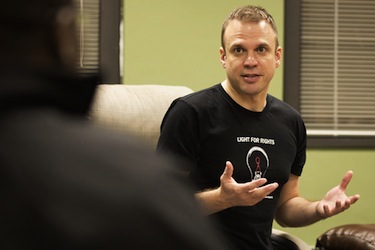 |
|
Nick Rhoades talks at a PITCH meeting in Waterloo, Iowa, in November. PITCH (Positive Iowans Taking Charge) is a support group for people living with HIV. Rhoades is currently on probation for criminal transmission of HIV. Photo: Stephen Mally.
|
Focus seems to have shifted, however, in how law enforcement and the courts use the laws. That shift has been creating another layer in the atmosphere of fear that already surrounds HIV — and contributes to ignorance and silence around knowing one’s status.
HIV is no longer the immanent death sentence it once was, but the stigma and fear continue — now aided by social media and exacerbated by law enforcement officials taking over the role perhaps best handled by public health authorities, who argue that criminalization laws as worded and as used only serve to undermine their efforts to convince people to get tested. If you know your status, you can be held legally culpable for not disclosing it.
As one astute commenter stated on the ProPublica site, “What we’ve learned in 30 years of this epidemic is that NOT talking is what spreads HIV. Those of you advocating punishment are advocating the spread of HIV.
“Ultimately what has to be said is that everyone who is not HIV positive is responsible for their own health, because you can’t know if the next person you’re having sex with is positive or not — because they don’t know! This is not ‘blame the victim’ but it is a letting-go of the victim-consciousness that rules our legal system. As long as we think there are ‘blameless victims’ we are not assigning responsibility for ending the epidemic where it belongs.”

Motor City Stalls Out, Bankruptcy Sets Precedent for Cutting Pensions
Detroit, Michigan — once the fourth-largest city in the United States and now 18th — was declared by a federal judge Tuesday to be eligible for bankruptcy. Known as the Motor City, its automobile industry once birthed the middle class; now it faces approximately $18 billion in debt, including $3.5 billion in pension obligations and $6 billion in health care costs.
Unions are big in Detroit, but they may not be big enough to stave off cuts to those pensions as the city figures out how to restructure itself. An average Detroit pensioner receives $19,000, which doesn’t leave much wiggle room for cuts. The problem here is not local. Detroit, rather, is seen as a test project for many other cities facing budget issues and the ongoing burden of pensions.
 |
|
Protesters in Detroit point out that slashing pensions is a giveaway to the city and to the banks. Photo: James Fassinger.
|
Another part of the plan to regain solvency could involve selling off assets such as public utilities and the Detroit Institute of Arts collection to private bidders, but that would raise only chump change in contrast with the city’s problems. Meanwhile, plans to build a nearly half-billion dollar hockey arena for the Detroit Red Wings, at the taxpayers’ expense, are going forward.
Detroit was already struggling financially when the 2008 recession struck a devastating blow to its housing market. At this point, about one third of the city’s 700,000 residents live in poverty, amidst insufficient services and record levels of violent crime.
However, most news outlets are not covering the role of state government in Detroit’s current situation.
In an interview Wednesday on Democracy Now! Wallace Turbeville, senior fellow at Demos and a former Goldman Sachs executive who worked in 1990 to help prevent the city’s credit rating from getting downgraded, explained more.
Kevyn Orr, Detroit’s emergency manager, was appointed against the wishes of the popular vote after the Michigan state legislature and the office of the governor swung far to the right politically in 2010, and passed a law allowing the state to appoint an emergency manager for a city.
An emergency manager is allowed to “basically become a dictator in that city for the duration of any financial crisis,” according to Turbeville.
Turbeville describes tension between the large urban cities in Michigan — which are predominantly African-American, Democrat and high in trade union membership — and the more conservative areas of the rest of the state as a factor in the motives of the largely Tea Party government.
“From a political standpoint, it serves the interest of Governor Snyder and his party to actually undercut the role of trade unions, because they’re the ones that are institutions opposed to his political viewpoint,” says Turbeville.
Whatever the motivations, the people of Detroit have a long, hard road ahead of them — and other large U.S. cities struggling with their revenue now know that the door is open to slash pensions.

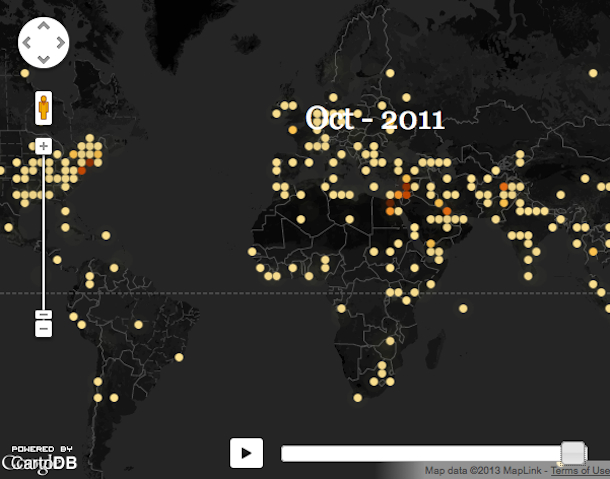
The Beauty of Data: Surprising Time-Lapse of Protests
Anyone really getting into the global manifestations of the Uranus-Pluto square and other astrological events linked to activism, citizen unrest and political protest, take note: Penn State doctoral candidate John Beieler created a time-lapse animated visualization of every protest on the planet since 1979. You know how the 1970s are categorized as highly charged, politically? Just wait till the map really gets going in the late 1990s with protests against globalization — and then in the last couple years with the Occupy Movement, environmental actions and more.

Orius New Moon, Mercury and Mars change signs
Link to program.
In this week’s edition of Planet Waves FM, I talk about the New Moon conjunct the newly discovered centaur planet Orius, which appears prominently in the charts of many innovators, including Steve Jobs, Ed Snowden and Julian Assange. I also cover Mercury ingressing Sagittarius and Mars ingressing Libra. Additionally, I give a rant on Obamacare and talk about the chart of the Metro-North train wreck. My musical guest is Hudson Valley-based Sasha Pearl, an extraordinary artist whose work you can explore on her website. For additional resources and the chart, please see the full post.

We are happy to offer once again one of our most popular products: the Planet Waves All-Access Pass for 2014. The All-Access Pass is for members who want access to everything we offer in a calendar year. In recent years our product line has grown considerably, and the response from our All-Access subscribers has been overwhelmingly positive. You can read about everything that’s included with an All-Access pass here. For those who can’t get enough Planet Waves astrology, it’s an unbeatable value.

Your Monthly Horoscopes — and our Publishing Schedule Notes
We published the extended monthly horoscope for December Friday, Nov. 29. Inner Space for November was published Friday, Nov. 1. We published Moonshine for the Taurus Full Moon Tuesday, Nov. 12. Moonshine for the Sagittarius New Moon was published Tuesday, Nov. 26. Please note, we normally publish the extended monthly horoscope on the first Friday after the Sun has entered a new sign; Inner Space usually publishes the following Tuesday.
Weekly Horoscope for Friday, Dec. 6, 2013, #978 | By Eric Francis
This is an Oracle edition of the horoscope — the sign readings have been selected from the archives by our Oracle program, one of the favorite subscriber features we offer. Regular horoscopes will resume next week.
Aries (March 20-April 19) — You are experiencing far too much anxiety for your own good. Worrying will not get the job done, besides which, you cannot rightly expect anything much to resolve itself with the planets in their current state. So please stop worrying. You are only wasting precious energy you could be allocating to sitting under a tree or hiding in the back of your favorite cafe scribbling in your notebook. I can assure you that as the next four weeks progress, each issue you are dealing with will resolve itself one by one. This will not be by magic, but miracles that arise from love, not fear.
Looking for an in-depth reading for the coming year? Pre-order THE MARS EFFECT, your 2014 annual readings, for a special rate of $79 for all twelve signs. It’s a great package of audio and written readings (plus bonus articles) that gives you access to your Sun, rising and Moon signs (and those of your loved ones). You may also pre-order individual signs for $19.95 here.
Taurus (April 19-May 20) — Ideas, revelations, solutions and numerous projects are flying circles around your head like jetliners around LAX. I suggest you let them land one at a time. No matter what you feel, you can’t actually do more than one thing at once. But you can do one thing at a time extremely effectively, and you can do it with a level of mastery quite beyond your years or experience. In fact the current moment is an opportunity to do some of the best work of your life. So keep burning the midnight oil.
Looking for an in-depth reading for the coming year? Pre-order THE MARS EFFECT, your 2014 annual readings, for a special rate of $79 for all twelve signs. It’s a great package of audio and written readings (plus bonus articles) that gives you access to your Sun, rising and Moon signs (and those of your loved ones). You may also pre-order individual signs for $19.95 here.

Gemini (May 20-June 21) — When my grandfather was working as a letter carrier in New York City, he was approached by a colleague with an idea: each would put up about $50 and they would have a pushcart where they would sell bagels with cream cheese, filled with crushed nuts. My grandfather thought it was too risky to get involved. The business became Chock Full o’ Nuts, and unfortunately, I am not one of its heirs. There really is no telling what’s a potentially lucrative venture in our time in history, but for your part, it needs to be more than a good idea. You must set out to make your fortunes not just in something you think will work, but in what you know will serve the community in a vital way that depends on your unique constellation of talents. You know it’s possible.
Looking for an in-depth reading for the coming year? Pre-order THE MARS EFFECT, your 2014 annual readings, for a special rate of $79 for all twelve signs. It’s a great package of audio and written readings (plus bonus articles) that gives you access to your Sun, rising and Moon signs (and those of your loved ones). You may also pre-order individual signs for $19.95 here.
Cancer (June 21-July 22) — There are two potent influences working in your solar chart this week. One is giving you a profound sense of certainty; the other, a troubling sense of doubt. You may wonder how these two factors can coexist simultaneously. You may wonder which to listen to; indeed, which is the truth. But I suggest you not rush or push for an answer. You need to look at the alternatives you face. Moreover, you need to understand the source of your doubts about yourself. When you catch a glimpse of that factor, a lot of things will make a lot more sense.
Looking for an in-depth reading for the coming year? Pre-order THE MARS EFFECT, your 2014 annual readings, for a special rate of $79 for all twelve signs. It’s a great package of audio and written readings (plus bonus articles) that gives you access to your Sun, rising and Moon signs (and those of your loved ones). You may also pre-order individual signs for $19.95 here.
Leo (July 22-Aug. 23) — A relationship is looking for some extra space within your household or living space. This may account for the pressure you’re feeling. It’s not enough to clear things up on the mental or emotional levels; the physical plane needs a lot of attention these days, and in your life right now that means freeing up a room or finding a space to spend time where there is enough room to have some freedom and uninterrupted time. The emotional challenges still persist — but will be easier in a clean, well-lighted place.
Looking for an in-depth reading for the coming year? Pre-order THE MARS EFFECT, your 2014 annual readings, for a special rate of $79 for all twelve signs. It’s a great package of audio and written readings (plus bonus articles) that gives you access to your Sun, rising and Moon signs (and those of your loved ones). You may also pre-order individual signs for $19.95 here.

Virgo (Aug. 23-Sep. 22) — In Western culture only rarely do we seem to get beyond the equation “you are what you do.” But how far from the truth is that? Yes, doing can exist on several levels, for example, as affirmation of what you know, or denial of it. You seem intent to make your reputation in the world and you are poised to succeed in a very big way. You have likely heard hints or seen glimpses of what is possible, and you may be wondering whether you deserve the recognition, the privilege and the authority that you feel coming. There is no question here. Remember what you’ve endured, stay close to the raw emotional vulnerability that unleashed your potential, and remember that you’ve managed to keep your faith up till the moment it needs you most.
Looking for an in-depth reading for the coming year? Pre-order THE MARS EFFECT, your 2014 annual readings, for a special rate of $79 for all twelve signs. It’s a great package of audio and written readings (plus bonus articles) that gives you access to your Sun, rising and Moon signs (and those of your loved ones). You may also pre-order individual signs for $19.95 here.
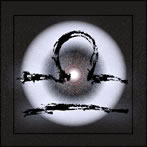
Libra (Sep. 22-Oct. 23) — There are certain people who when some worldly power is vested in them immediately strive to establish their position and make all kinds of changes. That would be ill advised right now. I suggest you take an approach that combines “wait and see” with the kind of leadership that stays focused on maintaining some continuity for a while. As recent events have demonstrated you don’t know everything and people are not going to tell you everything. Eventually you’ll find out everything you need to know but the operative word is eventually. So take your time to find out who your real allies are and solve important problems as they arise.
Looking for an in-depth reading for the coming year? Pre-order THE MARS EFFECT, your 2014 annual readings, for a special rate of $79 for all twelve signs. It’s a great package of audio and written readings (plus bonus articles) that gives you access to your Sun, rising and Moon signs (and those of your loved ones). You may also pre-order individual signs for $19.95 here.
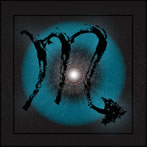
Scorpio (Oct. 23-Nov. 22) — Mercury recently making its way across Scorpio while so much else was currently happening in that sign is offering you a chance to learn quite a lot about the people closest to you, and to serve a function in their healing process. But healing is always a mutual experience, and a mutual reward. The law of grace demonstrates (among other things) that we can actually give what we don’t have, and yet it’s always a good idea to receive that very gift while we’re passing it on. What you have to offer these days is a measure of solidity, clarity and fullness that may have proven elusive in recent days. You’re in a great position to learn something from yourself.
Looking for an in-depth reading for the coming year? Pre-order THE MARS EFFECT, your 2014 annual readings, for a special rate of $79 for all twelve signs. It’s a great package of audio and written readings (plus bonus articles) that gives you access to your Sun, rising and Moon signs (and those of your loved ones). You may also pre-order individual signs for $19.95 here.

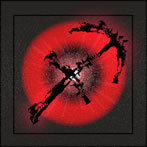
Sagittarius (Nov. 22-Dec. 22) — Imagine you’re standing between two mirrors. You want to see the front of you and the back of you at the same time. But you’re in the way, no matter how you do it, and you’re starting to get frustrated. What would happen if you got out of the way and allowed the mirrors to reflect one another? That would open up a seemingly infinite space, into which you could see in two distinct directions. Now, observe that this is all a metaphor. The ‘body’ is your ego consciousness; your sense of ‘I’. The mirrors may be two philosophies, two situations, two people, or most likely of all, your ongoing confrontation between the past and the future. If you get out of the way, they can have an authentic dialog. You’ll be able to make subtle adjustments and see their perspectives accurately. You’ll be able to feel your way down the two time tunnels, and sense which is the most authentically you.
Looking for an in-depth reading for the coming year? Pre-order THE MARS EFFECT, your 2014 annual readings, for a special rate of $79 for all twelve signs. It’s a great package of audio and written readings (plus bonus articles) that gives you access to your Sun, rising and Moon signs (and those of your loved ones). You may also pre-order individual signs for $19.95 here.
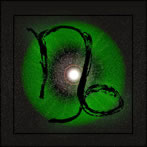
Capricorn (Dec. 22-Jan. 20) — When the rewards for all your hard work the past couple of years arrive they’re unlikely to be quite what you were expecting. Often the personal benefit of being in service is the opportunity to be of even greater service. So get used to it. Is this not exactly what you’ve been asking the universe for? What’s worth noting is that you’re being called upon to help in ways that only you can. You’ve built a reputation to a great extent on this fact alone. Success is no longer a matter of whether you fit in; it’s a matter of being entirely willing to play your precise role on the great stage of life. As such you can indulge fully in the experience; you can take every advantage that comes to you; you can afford to take a few risks.
Looking for an in-depth reading for the coming year? Pre-order THE MARS EFFECT, your 2014 annual readings, for a special rate of $79 for all twelve signs. It’s a great package of audio and written readings (plus bonus articles) that gives you access to your Sun, rising and Moon signs (and those of your loved ones). You may also pre-order individual signs for $19.95 here.
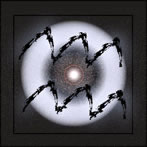
Aquarius (Jan. 20-Feb. 19) — Aquarians share a reputation, whether deserved or not, for being some of the most revolutionary people in the world, though also some of the most practical. I would encourage you not to compromise and think you have to be one way or the other right now. It turns out that the most innovative choice you can make or idea you can create has enormous practical value that will only increase with time. Yet it’s true that you need to cast aside all your brittle beliefs about what is possible or impossible, and go straight for what you know you want, or better still, what you know must be. Then, make it so.
Looking for an in-depth reading for the coming year? Pre-order THE MARS EFFECT, your 2014 annual readings, for a special rate of $79 for all twelve signs. It’s a great package of audio and written readings (plus bonus articles) that gives you access to your Sun, rising and Moon signs (and those of your loved ones). You may also pre-order individual signs for $19.95 here.
Pisces (Feb. 19-March 20) — People are watching, and noticing. Let’s just say that invisible is the last word I would use to describe your condition right now. So make your comments, your actions and your decisions count. The main risk you face is burning out on your own energy, so pace yourself, and before you do anything, ask if it really needs to be done, and what else might be more important. It may well be impossible to balance what seem to be personal needs against professional ones, but at the moment, professional is very, very personal.
Looking for an in-depth reading for the coming year? Pre-order THE MARS EFFECT, your 2014 annual readings, for a special rate of $79 for all twelve signs. It’s a great package of audio and written readings (plus bonus articles) that gives you access to your Sun, rising and Moon signs (and those of your loved ones). You may also pre-order individual signs for $19.95 here.
To unsubscribe, click here
e Wiki | Friends | Editors Contact Us
Copyright © 2013 by Planet Waves, Inc. All Rights Reserved. Other copyrights may apply.
Some images used under Fair Use or Share Alike attribution.
 Today, every living Western astrologer who writes or practices was taught that Pluto (discovered in 1930) was the furthest known planet and thus represented the edge of consciousness or reality as we know it. In astrology, the location and speed of a planet (particularly the last planet out) are important metaphors for its psychological and historical meaning. As the farthest known planet, the connotation was that Pluto represented, in a sense, the most fundamental concepts that the human race or individual person had to confront — and for decades this was true.
Today, every living Western astrologer who writes or practices was taught that Pluto (discovered in 1930) was the furthest known planet and thus represented the edge of consciousness or reality as we know it. In astrology, the location and speed of a planet (particularly the last planet out) are important metaphors for its psychological and historical meaning. As the farthest known planet, the connotation was that Pluto represented, in a sense, the most fundamental concepts that the human race or individual person had to confront — and for decades this was true.




























